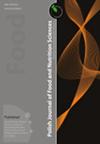球孢白僵菌多聚半乳糖醛酸酶澄清梨汁对其流变性、抗氧化性和品质的影响
IF 2.3
4区 农林科学
Q3 FOOD SCIENCE & TECHNOLOGY
引用次数: 4
摘要
尽管梨因其高营养含量而成为全球最受欢迎的水果之一,但其果汁产品由于其令人讨厌的模糊性和浑浊性而没有得到消费者的平等接受。然而,人们注意到果汁的酶处理比传统的滗析、过滤和加热方法更好地提高了果汁的整体可接受性,这些方法要么昂贵,要么对产品质量有害。在这项研究中,利用从球孢白僵菌内生真菌SAN01中提取的部分纯化的聚半乳糖酶,对梨汁进行了有效澄清。在酶量为39.37 U/mL、温度为36.87℃、处理时间为2.75 h的条件下,对果汁澄清工艺进行优化,澄清效果比对照提高137%。结果还表明,聚半乳糖醛酸酶处理导致梨汁的粘度显著降低,假塑性增加,果汁的流变学数据充分符合幂律模型(R2>0.9)。此外,酶辅助澄清果汁可降低褐变指数(-14.34%)和浊度(-19.72%),同时提高还原糖含量(9.55%)。与传统果汁处理不同,聚半乳糖醛酸酶处理保留了梨汁的抗氧化能力和总酚含量,处理后无明显变化。因此,本研究证明了真菌聚半乳糖醛酸酶在改善梨汁品质方面的功效,以及球孢白僵菌酶在食品工业中的潜在适用性。本文章由计算机程序翻译,如有差异,请以英文原文为准。
Pear Juice Clarification Using Polygalacturonase from Beauveria bassiana: Effects on Rheological, Antioxidant and Quality Properties
Although pear is one of the most preferred fruits globally due to its high nutrient content, its juice products have not received equal consumer acceptability due to their undesirable haziness and turbidity. However, enzymatic treatment of juice has been noted to improve the overall acceptability of juices better than traditional decantation, filtration, and heating methods, which are either expensive or detrimental to the product quality. In this study, pear juice was effectively clarified using partially purified polygalacturonase from an entomopathogenic fungal endophyte Beauveria bassiana SAN01. The optimization of the juice clarification process led to 137% improvement in clarification compared to control, under optimal conditions of 39.37 U/mL enzyme load, 36.87°C temperature and 2.75 h treatment time. Results also showed that the polygalacturonase treatment resulted in a significant decrease in viscosity and an increase in the pseudoplasticity of the pear juice as the rheological data of the juice was observed to fit adequately into the power law model (R2>0.9). Furthermore, the enzyme-assisted juice clarification was found to reduce browning index (-14.34%) and turbidity (-19.72%) while increasing the reducing sugar content (9.55%). Unlike some conventional juice treatments, the polygalacturonase treatment preserved the antioxidant potential and the total phenolic contents of the pear juice as no significant changes were observed after the treatment. This study thus demonstrates the efficacy of a fungal polygalacturonase in improving pear juice quality as well as the potential applicability of B. bassiana enzymes in the food industry.
求助全文
通过发布文献求助,成功后即可免费获取论文全文。
去求助
来源期刊

Polish Journal of Food and Nutrition Sciences
FOOD SCIENCE & TECHNOLOGY-
CiteScore
4.30
自引率
12.50%
发文量
25
审稿时长
20 weeks
期刊介绍:
The Polish Journal of Food and Nutrition Sciences publishes original, basic and applied papers, reviews and short communications on fundamental and applied food research in the following Sections:
-Food Technology:
Innovative technology of food development including biotechnological and microbiological aspects
Effects of processing on food composition and nutritional value
-Food Chemistry:
Bioactive constituents of foods
Chemistry relating to major and minor components of food
Analytical methods
-Food Quality and Functionality:
Sensory methodologies
Functional properties of food
Food physics
Quality, storage and safety of food
-Nutritional Research Section:
Nutritional studies relating to major and minor components of food (excluding works related to questionnaire
surveys)
-“News” section:
Announcements of congresses
Miscellanea
 求助内容:
求助内容: 应助结果提醒方式:
应助结果提醒方式:


